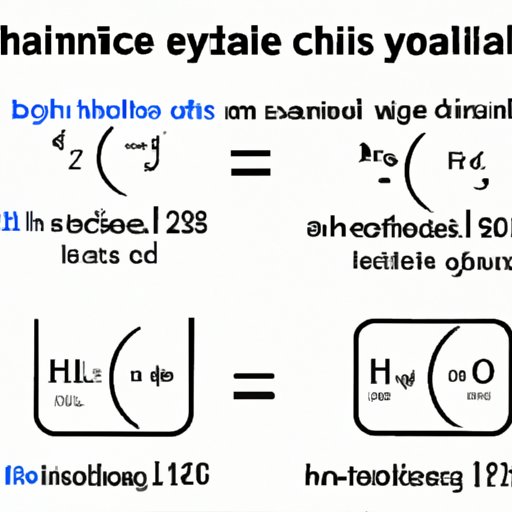
Introduction
Balancing equations is a fundamental skill in chemistry, used to ensure that chemical reactions occur in a predictable and controlled manner. Whether you’re a student studying for an exam or a professional working in a specialized field, understanding the process of balancing equations is essential. In this article, we will explore the key concepts, step-by-step process, practical tips and tricks, and real-world applications of balancing equations to help you master this crucial skill.
The Step-by-Step Guide to Balancing Equations
Before we delve into the specifics of balancing equations, let’s first define some key terms. A chemical equation represents a chemical reaction and includes the reactants (the substances that react) and the products (the substances that are produced). The coefficients are the numbers placed in front of each substance to balance the equation.
To balance an equation, follow these simple steps:
1. Write the unbalanced equation, including the reactants and products.
2. Count the number of atoms of each element on both sides of the equation.
3. Add coefficients to balance the number of atoms on each side.
4. Check that the number of atoms of each element is now equal on both sides.
For example, let’s balance the equation for the combustion of methane:
Unbalanced: CH4 + O2 → CO2 + H2O
Balanced: CH4 + 2O2 → CO2 + 2H2O
Here, we added a coefficient of 2 in front of O2 to balance the number of oxygen atoms on both sides of the equation.
For more complex equations, it may be helpful to identify certain groups of atoms that appear on both sides of the equation and balance them first. It’s also important to remember that any changes made to one side of the equation must be mirrored on the other side.
Mastering the Art of Balancing Equations – Tips and Tricks
Becoming proficient at balancing equations takes time and practice, but there are several practical tips and tricks that can help you along the way. One helpful tool is algebraic equations, which can be used to rearrange and solve for unknown coefficients.
Trial-and-error is another useful approach, especially when dealing with more complex equations. By experimenting with different coefficients and checking your work, you can eventually arrive at the correct balance.
Intuition also plays a role in balancing equations, as you become more comfortable with the process and begin to recognize common patterns. For example, some reactions may involve the exchange of ions, which can cancel each other out and simplify the equation.
Balancing Chemical Equations: A Beginner’s Guide
When dealing with chemical equations, it’s important to know that different types of chemical reactions require different approaches to balance them. For example, combustion reactions, like the one we just balanced, involve the reaction of a hydrocarbon with oxygen and typically involve balancing the number of oxygen and hydrogen atoms.
Other common types of chemical reactions include single and double displacement reactions, precipitation reactions, and acid-base reactions. By familiarizing yourself with these different types of reactions and their accompanying equations, you can better understand how to approach balancing them.
Stoichiometry is another key concept to keep in mind when balancing chemical equations. This is the study of the quantitative relationships between reactants and products in a chemical reaction and is used to ensure that the correct amounts of each substance are present.
Practice Makes Perfect: Exercises for Balancing Equations
The best way to improve your skills in balancing equations is through practice. Below are a few exercises to help you get started, with increasing levels of difficulty:
1. H2 + O2 → H2O
2. NaCl + AgNO3 → NaNO3 + AgCl
3. C3H8 + O2 → CO2 + H2O
4. NaHCO3 + HCl → NaCl + H2O + CO2
5. FeCl3 + MgO → Fe2O3 + MgCl2
Don’t forget to check your work and double-check your coefficients to ensure accuracy.
Visual Learning: How Illustrated Tutorials Help with Balancing Equations
Visual aids can be incredibly helpful in understanding complex concepts like balancing equations. Illustrated tutorials and videos can provide step-by-step guidance, clear examples, and visual representations of the equations.
There are plenty of resources available online, from educational websites to YouTube videos, that can help you better understand and master the art of balancing equations. You can even create your own visual aids, such as flashcards or diagrams, to supplement your learning.
Common Mistakes to Avoid When Balancing Equations
Even with practice, it’s easy to make mistakes when balancing equations. Some of the most common errors include forgetting to balance polyatomic ions, miscalculating coefficients, and forgetting to simplify the equation when possible.
To avoid these mistakes, it’s important to double-check your work and carefully review the equation for any errors. It’s also helpful to work slowly and methodically, instead of rushing through the process.
Why Balancing Equations is Essential in Chemistry and Everyday Life
Balancing equations is not just an academic exercise – it has practical applications in a variety of fields, from pharmaceuticals to agriculture to cooking.
In medicine, for example, unbalanced chemical reactions can result in ineffective medications or even harmful side effects. In agriculture, the use of fertilizers and pesticides requires a careful understanding of chemical reactions to ensure that plants receive the correct nutrients.
Similarly, in cooking, the chemical reactions that occur between ingredients are crucial to achieving desired flavors and textures. Balancing equations is also important in reducing waste and environmental pollution.
Conclusion
Balancing equations may seem daunting at first, but with practice and perseverance, anyone can master this essential skill. Remember to approach each equation step-by-step, use practical tips and tricks, and take advantage of visual aids when needed.
By understanding the process of balancing equations, you’ll not only excel in your studies or job, but you’ll also gain a deeper appreciation for the practical applications of chemistry in everyday life.




